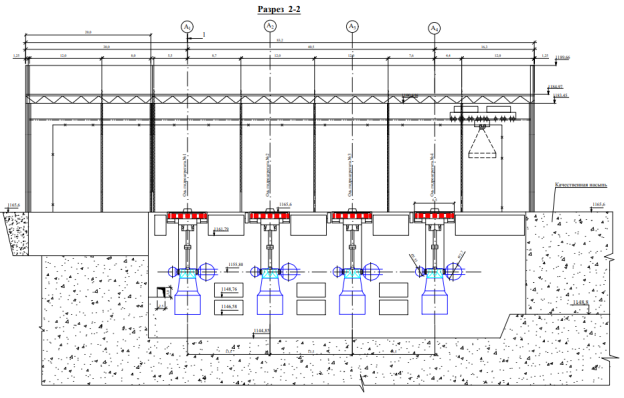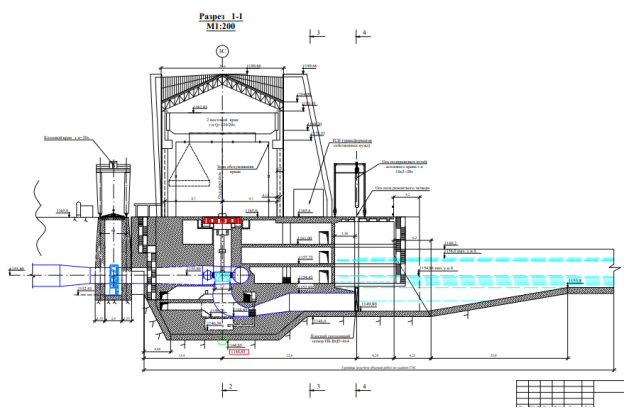This article provides a comprehensive assessment of the Yavan Hydroelectric Power Plant's (HPP) hydro technical structures with a primary focus on safety criteria. The study encompasses an in-depth analysis of the hydraulic structure's characteristics, specifications, and parameters. Detailed attention is given to the concrete spillway dam construction, including its main features and functions. Hazard identification associated with the HPP's operation is systematically conducted, evaluating the probability of various emergency situations and assessing potential consequences on the economy and human life.
Environmental Impact Assessments (EIAs) are integrated into the study to gauge the ecological implications of the HPP's activities. The research further delves into the development of safety criteria for the hydraulic structure, scrutinizing the current state for compliance and proposing necessary measures to ensure adherence to these criteria. A comprehensive set of measures to prevent emergencies and minimize consequences is outlined, accompanied by an evaluation of their effectiveness and recommendations for improvement.
Drawing on a review of best practices and experiences from other hydraulic structures, the article concludes with a synthesis of findings and a strategic perspective on enhancing the safety and sustainability of the Yavan HPP. This research contributes to the broader field of hydraulic engineering, emphasizing the importance of robust safety criteria and proactive measures in the operation of hydro technical structures.
Keywords: Hydro technical structures, Safety criteria, Concrete spillway dam, Environmental Impact Assessment, Emergency prevention, Hydraulic engineering.
1.1. Characteristics of the hydraulic structure of the Yavan HPP
Yavan HPP is a hydraulic structure located on the Zervshvan River in Tajikistan. It will be built to generate electricity and improve irrigation in the area. Yavan HPP has an installed capacity of 144 MW and consists of 4 hydraulic units. It is one of the key sources of electricity in the region and plays an important role in the economic development of Tajikistan. However, like any hydraulic structure, Yavan HPP is at risk of emergency situations that can have serious consequences for the environment and the population. To ensure the safety of the structure, an assessment and safety criteria are necessary, as well as the development of appropriate measures. [6]
1.2. Specifications and parameters HPP

Table 1
Technological equipment, HPP capacity and power generation
|
1.1 |
Installed capacity of hydroelectric power plants, MW |
36x4=144 |
|
1.2 |
The capacity of hydroelectric power plants during the operation of 4 MW turbines |
-135,33 |
|
1.3 |
Guaranteed HPP capacity, MW |
-36 |
|
2.0 |
Estimated upstream levels, m |
- 1230 |
|
2.1 |
Normal retaining water level (NPU), m |
- 1230 |
|
2.2 |
Energy triggering, m |
-15 |
|
2.3 |
Lowest level (UMO), m |
-1215 |
|
3.0 |
Calculated levels in the downstream, m |
-1155,8 |
|
3.1 |
Flood level, 0.01 %, m |
-1160,08 |
|
3.2 |
The lowest level of low water, m |
-1154,13 |
|
4.0 |
Pressure losses in the derivational conduit during operation of 1 agr., m |
-1,08 |
|
5.0 |
Heads «net» when working 1 agr., m: |
-73,12 |
|
5.1 |
Largest, m |
-74,2 |
|
5.2 |
Weighted average, m |
-71,07 |
|
5.3 |
Calculated at work 1 agr., m |
- 73,12 |
|
5.4 |
Minimum, m |
-64,54 |
|
6.0 |
Number of hours of use (by watercourse) of installed capacity, taking into account the operation of hydroelectric power plants in the daily regulation mode, h |
– 4584 |
|
7.0 |
Electricity generation, MWh | |
|
7.1 |
Annual average, including: | |
|
-Summer |
-576,0 | |
|
-Winter |
-84,0 | |
|
- the ratio of winter production to the average annual |
-660,0 | |
|
8.0 |
Requirements of the power system for the operating modes of hydroelectric power plants |
1.3. Characteristics of the route and construction site in the HPP
The hydroelectric power station is an integral part of the hydroelectric complex, which, in addition to the station, includes water-lifting and spillway structures, protective structures, reservoirs and upstream of water intake nodes.
The type of hydroelectric power station, its location and the composition of structures were determined by the purpose of the hydroelectric complex, its parameters, the natural conditions of the site for the location of the hydroelectric complex on the basis of a technical and economic comparison of possible options for a technical solution.
After carrying out fitting work on the Zeravshan River, the location of the alignment in question and its technical parameters were finally clarified. [4]
Description of the alignment of the hydroelectric power station
The structure of the hydroelectric complex includes:
— The building of the hydroelectric power station.
— Spillway dam (aka water-lifting).
— Water intake facility.
— Derivation tunnel.
— Block of water intake structure of construction and operational spillway
— Construction and operational spillway (CMEA).
— Diversion channel from the exit portal of the construction tunnel to the Zeravshan River
— River flow control basin and enclosing dam.
— Diversion channel from the building of the hydroelectric power station.
The presence of a gravel-pebble base allows you to have a building of a hydroelectric power station, a SEC of any number of storeys.
The issue of switching the Zeravshan River to a construction and operational spillway (CMEA) for the construction period is being resolved positively.
The creation of a reservoir of small capacity (77.545 million m3 ), located in the canyon of the Zeravshan River, causes minimal alienation. [4]
2.1. Assessment of hazards associated with the operation of a hydraulic structure
Assessment of the hazards associated with the operation of the hydraulic structure is an important step in ensuring the safety of the Yavan HPP. As part of this work, it is necessary to analyze the potential hazards and risks associated with the operation of the Yavan HPP, as well as to determine the possible consequences and the likelihood of their occurrence. Based on this assessment, recommendations will be developed to eliminate and minimize dangerous situations.
The main objectives of this stage:
— Assessment of the probability and consequences of possible accidents and emergencies associated with the operation of the Yavan HPP.
— Analysis of factors that may contribute to the occurrence of dangerous situations.
— Evaluation of the effectiveness of existing security monitoring and control systems, as well as the development of recommendations for their improvement.
— Development of measures to prevent and minimize the consequences of possible accidents and emergencies.
Conducting a hazard assessment will not only improve the safety of the Yavan HPP, but also reduce the likelihood of negative environmental consequences that may occur in the event of accidents or emergencies.[2]
2.2. Identification of possible threats and dangers
Identification of possible threats and hazards is one of the most important tasks in assessing the safety of a hydraulic structure. To do this, an analysis of man-made and natural factors that may affect the operation and safety of the Yavan HPP is carried out. Techno genic factors include emergency depressurization of hydraulic structures, failure of electrical equipment, personnel errors, etc. Natural factors include floods, earthquakes, landslides, etc.
As a result of the identification of threats and hazards, a list of potential emergency scenarios that may occur at the Yavan HPP will be determined. This will make it possible to develop measures to prevent such situations and minimize possible consequences. [7]
2.3. Assessment of the probability of occurrence of various emergency situations
Assessment of the probability of occurrence of various emergency situations is an important step in assessing the safety of the hydraulic structure of the Yavan HPP. For this purpose, an analysis of the history of operation of similar structures is carried out, as well as possible climatic and geological conditions of the region in which the Yavan hydroelectric power station is located are taken into account. Assessment of the probability of occurrence of emergency situations allows you to determine the most likely scenarios and develop measures to prevent and eliminate the consequences of these situations. [5]
2. 4. Assessment of possible consequences for the economy and human life
Assessment of possible consequences for the environment, economy and human life is an important task in assessing the safety of the hydraulic structure of the Yavan HPP. To do this, it is necessary to analyze various emergency scenarios that may arise during the operation of the dam and hydroelectric power station.
As a result of this analysis, it is possible to determine the probability and scale of possible consequences. For example, if a dam breaks, there can be serious consequences for the environment, such as flooding and flooding, as well as threats to human life and economic facilities downstream. Destruction of hydraulic structures can also occur, which can lead to large economic losses.
Assessment of possible consequences is a necessary step for the development of measures to prevent emergencies and minimize their consequences. [2]
2.5 Environmental Impact Assessments (EIAs)
This report outlines the preliminary findings of an environmental and social survey for the Yavan Hydroelectric Power Plant (HPP) in the Aini district of Tajikistan. The construction aims to harness the Zeravshan River's hydropower potential, addressing energy shortages in the region. Tajikistan faces a significant energy crisis, impacting both urban and rural areas. The planned HPP undergoes Environmental Impact Assessment (EIA) in line with environmental protection laws. The study focuses on analyzing the study area's natural features, historical heritage, and ecosystem state. The goal is to inform optimal design solutions ensuring a balance between social, environmental, and economic aspects. Preliminary environmental impacts are discussed, guided by compliance with existing standards and taking into account the region's natural conditions. Data from Nurofar Institute's specialized departments contribute to this report, providing insights that can be refined during the ongoing study. [5]
3.1. Safety criteria for the hydraulic structure of Yavan HPP
The safety criteria for the hydraulic structure of the Yavan HPP may include the following aspects:
- Hydraulic safety: assessment of the resistance of the hydraulic structure under normal and emergency operating conditions, evaluation of the effectiveness of the water flow control system.
- Geotechnical safety: assessment of the stability of the dam, foundation and other geotechnical elements, analysis of the impact of environmental factors (earthquakes, seismic waves, floods) on geotechnical resistance.
- Environmental safety: assessment of the impact of hydraulic structures on the environment (water, terrestrial and air ecosystems), analysis of possible consequences of pollution of water, soil and atmosphere.
- Technological safety: assessment of risks associated with the process of electricity production and hydraulic structure management, analysis of possible emergency situations and their consequences.
- Social security: assessment of risks associated with the life and health of people in the area of operation of the hydraulic structure, analysis of measures to protect the population from possible dangers.
- Economic safety: assessment of the degree of economic efficiency of the hydraulic structure, analysis of possible economic risks and losses associated with its operation. [7]
4. 1. Measures to ensure the safety of the hydraulic structure of the Yavan HPP.
To ensure the safety of the hydraulic structure of the Yavan HPP, it is necessary to implement a number of measures that would guarantee reliable protection of human life and health, the environment, as well as the hydraulic structures themselves.
The first step should be regular inspection and monitoring of the condition of all elements of the HPP, including the dam, hydraulic turbines, generators, control systems, etc. This will allow you to quickly identify potentially dangerous defects and take measures to eliminate them. [4]
To ensure the reliable operation of hydroelectric power plants, it is also necessary to ensure its effective automation and a control system that would promptly respond to possible emergency situations.
Also an important aspect is the training of HPP personnel in the rules of safe operation, as well as regular training on evacuation and actions in emergency situations.
An important role in ensuring safety is played by the system for monitoring the water level in the river on which the hydroelectric power station is located. To do this, it is necessary to install automatic sensors that would promptly report a possible increase in the water level.
Also, to ensure safety, it is necessary to take into account the opinion of experts and the public, hold regular public hearings and inform the public about possible risks.
In general, ensuring the safety of the hydraulic structure of the Yavan HPP requires an integrated approach and the implementation of many measures. An important aspect is the constant monitoring and updating of security measures in accordance with changing conditions and requirements. [4]
4.2. Development of measures to prevent accidents and minimize the consequences
To ensure that the hydraulic structure meets safety criteria, it is necessary to develop measures to prevent possible emergencies and minimize their consequences. These measures may include:
Development of a program of regular inspection and maintenance of the facility with the participation of experienced specialists and the use of modern equipment to detect and eliminate potential problems.
Installation and use of automatic monitoring and control systems that allow you to quickly identify any deviations in the operation of the structure and take measures to eliminate them.
Training of personnel responsible for the operation of the facility in the technical skills and knowledge necessary to ensure safe operation and prompt response to possible emergencies.
Development of evacuation plans and emergency measures that will minimize the consequences of any emergency situations.
Determination of spare capacities and backup systems to ensure non-operational operability of the structure in case of emergencies.
Development of plans and measures to protect the environment and wildlife from possible negative impacts associated with the operation of a hydraulic structure.
All these measures should be carefully designed and taken into account when developing a strategy for ensuring the safety of the hydraulic structure of the Yavan HPP. [10]
Conclusion
In conclusion, the article on the topic «Assessment and safety criteria of the hydraulic structure of the Yavan HPP» typically summarizes the study's results, presenting key findings, and formulating main conclusions and recommendations. It is crucial to highlight the obtained results, underscoring the significance of evaluating the safety of hydraulic structures, particularly in the context of the Yavan HPP, and stressing the necessity for continuous monitoring and enhancement of safety measures.
Furthermore, the conclusion may delve into key recommendations aimed at improving safety criteria and ensuring their compliance. Additional measures to prevent accidents and minimize potential consequences should be proposed. Emphasizing the importance of exchanging experiences and adopting best practices from other hydraulic structures becomes pivotal in shaping effective safety measures and preventing emergencies in the future.
Application

Fig. 1. Longitudinal section of the Yavan HPP

Fig. 2. Cross section of the Yawan HPP
References:
- The law of the republic of Tajikistan on the safety of hydraulic structures (Akhbori Majlisi Oli of the Republic of Tajikistan, 2010, No. 12, part 1, Article 825; Laws of the Republic of Tajikistan dated 02.01.2018, No. 1500; dated 17.05.2018, No. 1534)
- Ibatullin S. R., Radkevich D. B. Safety of hydraulic structures in Central Asia: problems and approaches to their solution. — Almaty, 2011. 40 p.
- Methodical manual. Prepared with the support of the United Nations Economic Commission for Europe and the International Fund for Saving the Aral Sea development and creation. Complex measures to ensure the safety of hydraulic structures. 2013.-85 p.
- Vasiliev Yu.S., Samorukov I. S., Khlebnikov S. N. Basic energy equipment of hydroelectric power plants. Composition and selection of basic parameters: Textbook. posobie. SPb.: Izd-vo SPbSTU, 2002. -134 p.
- Lyapichev Y. P. Hydrological and technical safety of hydraulic structures: Textbook. posobie. — M.: RUDN, 2008. — 222 p.
- Lyapichev Y. P. Hydraulic structures: Textbook. posobie. — M.: RUDN, 2008. — 302 p
- Sobolem, S.V. and Trelev, A. V. Textbook «Safety of Hydraulic Objects», is a study of the safety of hydraulic objects. Written and published in 2018.-203 p.
- SNiP 2.06.01–86 Hydraulic structures. The main provisions of the design M.1987.
- SNiP 2.06.04–82 * Loads and impacts on hydraulic structures (wave, ice and from ships) M.1986.
- This Declaration of Safety of Hydraulic Structures at Sangtudinskaya HPP-1 was drawn up in accordance with the Law of the Republic of Tajikistan “On the Safety of Hydraulic Structures” No. 666 dated 12/29/2010.

